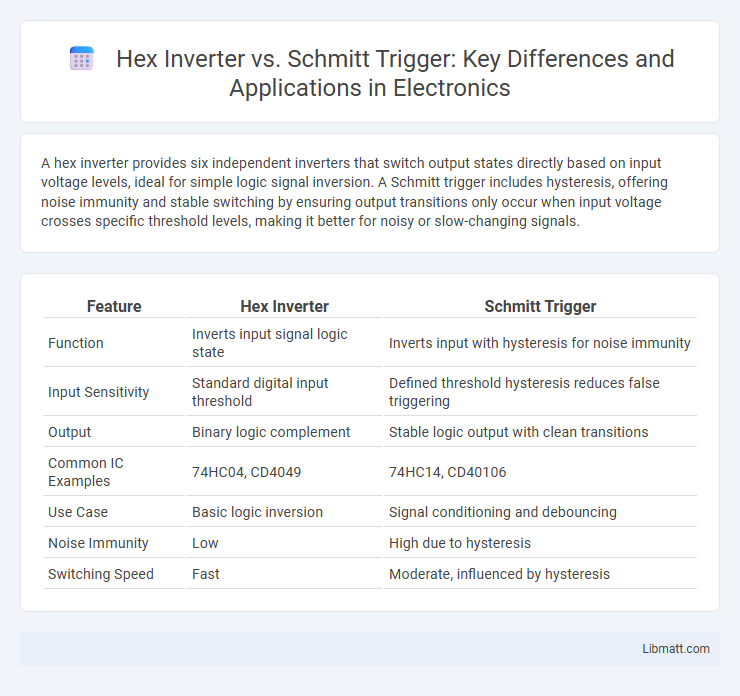A hex inverter provides six independent inverters that switch output states directly based on input voltage levels, ideal for simple logic signal inversion. A Schmitt trigger includes hysteresis, offering noise immunity and stable switching by ensuring output transitions only occur when input voltage crosses specific threshold levels, making it better for noisy or slow-changing signals.
Table of Comparison
| Feature | Hex Inverter | Schmitt Trigger |
|---|---|---|
| Function | Inverts input signal logic state | Inverts input with hysteresis for noise immunity |
| Input Sensitivity | Standard digital input threshold | Defined threshold hysteresis reduces false triggering |
| Output | Binary logic complement | Stable logic output with clean transitions |
| Common IC Examples | 74HC04, CD4049 | 74HC14, CD40106 |
| Use Case | Basic logic inversion | Signal conditioning and debouncing |
| Noise Immunity | Low | High due to hysteresis |
| Switching Speed | Fast | Moderate, influenced by hysteresis |
Introduction to Hex Inverter and Schmitt Trigger
A Hex Inverter is a digital logic IC containing six independent NOT gates that invert input signals, ideal for signal processing and logic level conversion. A Schmitt Trigger, on the other hand, is a comparator circuit with hysteresis designed to clean noisy or slowly changing input signals by providing a stable digital output. Your choice between the two depends on whether you need simple signal inversion or noise immunity with improved signal integrity.
Understanding the Basic Operation
Hex inverters consist of six independent inverter gates that produce a low output for a high input and a high output for a low input, enabling signal inversion. Schmitt triggers enhance signal stability by incorporating hysteresis, which provides distinct threshold voltages for switching, thus preventing noise-induced false triggering. The primary difference lies in the Schmitt trigger's ability to clean up noisy or slow input signals, while the basic hex inverter simply inverts the input without noise immunity.
Key Differences in Functionality
Hex inverters provide simple digital logic inversion with fast switching, ideal for basic signal processing tasks. Schmitt triggers incorporate hysteresis, enabling them to clean noisy signals by switching output only when input crosses defined threshold levels. Your choice hinges on whether signal noise tolerance or straightforward inversion is the primary functionality needed.
Circuit Symbol and Pin Configuration
The hex inverter features six independent inverters within a single package, typically represented by a triangle with a small circle at the output in its circuit symbol, and usually comes in a 14-pin dual in-line package (DIP). The Schmitt trigger symbol resembles an inverter but includes a hysteresis characteristic indicated by a slightly different input shape, and it often shares a similar 14-pin DIP configuration. Pin assignments for both IC types correspond to power supply (Vcc and GND) and input-output pairs for each gate, but Schmitt triggers emphasize noise immunity with specific input threshold pin setups.
Noise Immunity: Schmitt Trigger’s Advantage
Schmitt triggers offer superior noise immunity compared to hex inverters due to their hysteresis characteristic, which prevents small fluctuations in input signals from causing false output transitions. This built-in hysteresis creates distinct threshold voltages for switching ON and OFF, significantly reducing susceptibility to noisy or slow-changing signals. As a result, Schmitt triggers are ideal for applications requiring stable digital signal processing in electrically noisy environments.
Applications of Hex Inverters
Hex inverters are widely used in digital circuits for signal inversion, waveform generation, and logic level conversion. Common applications include clock signal shaping, pulse width modulation, and creating oscillators or timers in embedded systems and microcontroller projects. Their ability to invert multiple signals within a single package makes Hex inverters essential in simplifying circuit design and minimizing component count.
Applications of Schmitt Triggers
Schmitt triggers are widely used in signal conditioning circuits to convert noisy or analog signals into clean digital outputs by providing hysteresis, which stabilizes the output and prevents false triggering. Your applications often include debouncing mechanical switches, shaping waveform signals in oscillators, and improving the performance of sensors by filtering out noise and ensuring reliable digital transitions. Unlike standard hex inverters, Schmitt triggers excel in environments with slow or noisy input signals, making them essential for robust digital circuit designs.
Performance Comparison: Speed and Signal Integrity
Hex inverters offer faster switching speeds due to their simpler CMOS inverter design, making them suitable for high-frequency applications where speed is critical. Schmitt triggers provide superior signal integrity by incorporating hysteresis, which filters out noise and prevents false triggering on slow or noisy input signals. In environments with noisy or slowly varying inputs, Schmitt triggers maintain stable output transitions, while hex inverters excel in low-latency, clean digital signals.
Design Considerations and Selection Criteria
When selecting between a Hex inverter and a Schmitt trigger, key design considerations include noise immunity, signal integrity, and input threshold behavior. Hex inverters provide standard digital inversion with sharp switching but can be susceptible to noise and slow input transitions, while Schmitt triggers incorporate hysteresis to improve noise margins and ensure clean output transitions in noisy or slow-changing signals. Your choice should align with the application's signal characteristics and noise environment to ensure reliable performance.
Summary: Choosing the Right Component
When selecting between a hex inverter and a Schmitt trigger, consider signal integrity and noise immunity requirements. A hex inverter provides straightforward logic inversion but lacks hysteresis, making it less effective for noisy or slowly changing input signals. A Schmitt trigger offers improved noise rejection and clean switching transitions due to its hysteresis, ensuring Your circuits maintain reliable performance in challenging environments.
Hex inverter vs Schmitt trigger Infographic

 libmatt.com
libmatt.com